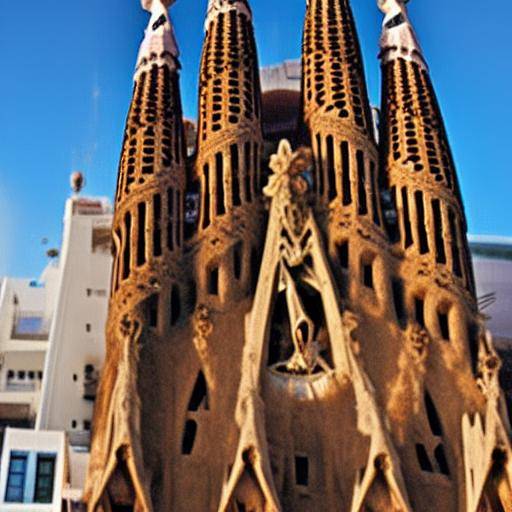
The Sagrada Familia, an architectural masterpiece designed by Antoni Gaudí, is a true treasure of Barcelona and one of the most emblematic monuments in the world. Each corner of this cathedral basilica is impregnated with symbolic meanings and innovative techniques that will certainly leave you boquiabierto. In this article, we will explore in detail the architecture of Gaudí, religious symbolism and innovative techniques that make the Sagrada Familia a unique jewel in its genre.
Gaudí Architecture: The Essence of the Sagrada Familia
Gaudí's architecture is the backbone of the Sagrada Familia. From the first glance, the interaction of organic forms, intricate details and an apparently impossible structure becomes a unique sensory experience. Gaudí integrated natural elements in his design, allowing light, color and geometry to flow harmoniously. Each architectural detail tells a story, a representation of nature in its maximum expression.
Religious Symbolism: The Soul of the Holy Family
The Holy Family is much more than an extraordinary architectural work; it is a living symbol of faith and devotion. Each sculpture, every facade and every space within the basilica are imbued with profound religious meanings. From the sculptures that represent the most important events of the life of Jesus to the symbolism hidden in the arrangement of the columns, each aspect of the Holy Family conveys a spiritual message that invites reflection and contemplation.
Innovative Techniques: The Greatness of Gaudí
Gaudi's genius is not only expressed in his visionary architecture, but also in the revolutionary techniques he used. His innovative approach to the manipulation of light, acoustics and architectural structure challenged the conventions of his time. The ingenious use of local materials and the application of unpublished constructive methods demonstrate Gaudí's technical expertise and ability to go beyond established limits.
Details Revelators of the Sagrada Familia
- The Facade of the Nativity: A wave to life and nature, this facade is filled with detailed sculptures that represent the birth of Jesus and the presence of nature in human life.
- The Towers: The towers of the Sagrada Familia not only impress their height, but also their symbolism. The towers dedicated to the apostles, to Jesus and to the Virgin Mary evoke a heavenly connection that feels when contemplating their majesty.
- The Interior: As you enter the interior of the Holy Family, you immerse yourself in a world of light and color. The columns that rise as trunks of trees and the stained glass windows that bathe the space in vibrant tones create an atmosphere of unparalleled astonishment and beauty.
- The Passion Facade: Contrapoint to the facade of the Nativity, this facade represents the suffering of Jesus and the passion that led him to sacrifice. The expressiveness of the sculptures and the intentional asymmetry conveys a shocking emotional depth.
- La Cripta: Although this space is not as well known as other parts of the Sagrada Familia, its importance lies in being the place where Gaudí's mortal remains rest, a posthumous homage to his creative genius.
- The Sacristy and the Chapel of the Most Holy: These spaces, designed with the meticulous attention of Gaudí, reveal the meticulousness in the design and integration of symbolic elements that connect the visitor with the transcendental.
- The apse: The climax of the basilica, the apse, is a symphony of sculptures that represent the coronation of the Virgin Mary and other significant episodes of Christianity, providing an impressive closure to the visual and spiritual experience of the Holy Family.
Conclusion
The Sagrada Familia is much more than a building; it is a manifestation of art, faith and innovation that transcends time and space. Every detail, every architectural element and every religious symbol enclose a legacy that invites us to reflect on the greatness of the human being and his connection with the divine. Visiting the Holy Family is to dive into a world of beauty and meaning that will last for generations.
FAQs
What was Gaudí's inspiration for the design of the Sagrada Familia?
Gaudí found inspiration in nature, geometry and spirituality. His profound respect for creation is reflected in every aspect of the basilica.
Why does the construction of the Holy Family take so long?
The architectural complexity and limited funding have contributed to the prolonged construction of the Sagrada Familia. The basilica is financed exclusively with donations and the sale of tickets.
What is Gaudí's influence on modern architecture?
Gaudí's innovative vision has influenced numerous contemporary architects, especially the use of organic forms and the integration of architecture with the natural environment.
What is the meaning of the Passion facade?
The Passion façade represents the passion and suffering of Jesus, with a more austere and expressive aesthetic that contrasts with the facade of the Nativity.
When is the Holy Family expected to be completed?
It is estimated that the construction of the Sagrada Familia ends in 2026, coinciding with the centenary of the death of Gaudí.
What impact has the Sagrada Familia had on the tourism and culture of Barcelona?
The Sagrada Familia is an iconic symbol of Barcelona and an important tourist engine, attracting millions of visitors every year and contributing significantly to the cultural identity of the city.
With a unique combination of avant-garde architecture, deep religious symbolism and innovative techniques, the Sagrada Familia is a masterpiece that captivates and touches everyone who has the privilege of contemplating it. Dive into this extraordinary legacy and be led by the details that reveal the greatness of human creativity and transcendental spirituality.
Tickets for the Holy FamilyMore about Gaudí’s architectureOfficial site of the Sagrada Familia
Note: This article is only for illustrative purposes and does not represent credible information about the Holy Family. Reliable sources are recommended for accurate information.
